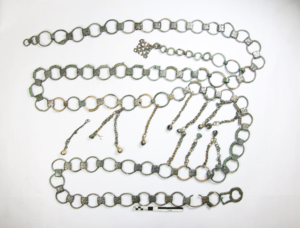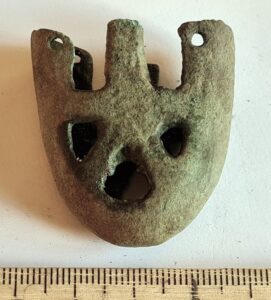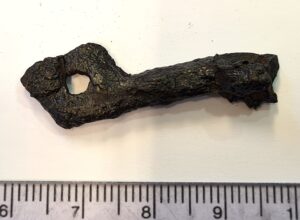Database
Our database is free to use for all history and archaeology enthusiasts. If you use our database, please do not forget to cite correctly:
Mägi, Marika; Palm, Piia Sandra. Archaeological Artefacts of Saaremaa. Foundation Osiliana / Tallinn University. Accessed: date.
The Osiliana Archaeological Database presents artefacts from Saaremaa and the surrounding small islands.
The database contains mainly Iron Age and Medieval finds that can be classified.
Undated metal or other pieces were generally excluded from the database.
Ceramics are represented by isolated examples.
The database is a work in progress and is constantly being updated.
Laheküla
Fragment of bracelet, bronze. Probably a hollow bracelet with narrowing ends, as found in 13th-century inhumations in Saaremaa. Fragment with typical ornamentation.


Fragment of a bracelet, bronze. Probably a hollow bracelet with narrowing ends, as found in 13th-century inhumations in Saaremaa (Mägi et al 2019, 97). Fragment with typical ornamentation.
Literature:
Mägi, M.; Malve, M. & Toome, T. 2019. Early Christian burials at Valjala churchyard, Saaremaa. – Archaeological Fieldwork in Estonia 2018, 93−118.

Laheküla
Fragment of penannular brooch, copper alloy. Half of the ring and a flat knob-shaped terminal. Medieval or early Modern time.
Laheküla
Buckle, iron. With square frame. Probably 12th-14th century, but may be later.


Buckle, iron. With square frame. Probably 12th-14th century, but may be later.
Laheküla
Fragment of penannular brooch with lily-shaped terminals, copper alloy.

Fragment of penannular brooch with lily-shaped terminals, copper alloy. Such brooches are known from medieval inhumations in Couronia, where they are dated from the second half of the 14th century to the third quarter of the 15th century (Vaska 2017, 62-64).
Literature:
Vaska, B. 2017. Rotas un ornaments Latvijā no 13.gs. līdz 18.gs. vidum. Latvijas Nacionālais vēstures muzejs. Rīga.
Länga
Belt chain, bronze. It is composed of 68 larger rings connected by mainly cubic-shaped distributers. The rings are ±3 cm in diameter, some have spirals slided upon them. From the rings hang 12 small spherical and four-pronged beads and a cross-pin, attached with 7 cm long chains.



Belt chain, bronze. It is composed of 68 larger rings connected by mainly cubic-shaped distributers. The rings are ±3 cm in diameter, some have spirals slided upon them. From the rings hang 12 small spherical and four-pronged beads and a cross-pin, attached with 7 cm long chains. The cross-shaped pendant belongs to the same type as those found at Varbola hillfort, and from the inhumation cemetery at Kaberla (Kurisoo 2013, fig. 23:59), and most recently in Saaremaa at the Mullutu harbour site (Mägi 2021). It belongs to the 13th century. At one end of the belt was a flat buckle with a rounded front.
The total length of the belt chain is 2.41 m. Similar belt chains have been found in several 13th-century inhumations, in Saaremaa especially in the graves near the Valjala church (Mägi et al 2019).
Kirjandus:
Kurisoo, T. 2013. Hilisrauaaegsed ristripatsid ja ristimärgiga rinnalehed Eestis. Magistritöö. Tartu.
Mägi, M. 2021. Viking Age and Medieval harbour site at Mullutu in southern Saaremaa. – Archaeological Fieldwork in Estonia 2020. Tallinn: Muinsuskaitseamet, 107-120.
Mägi, M.; Malve, M. & Toome, T. 2019. Early Christian burials at Valjala churchyard, Saaremaa. – Archaeological Fieldwork in Estonia 2018, 93−118.
Länga
Sword scabbard end, bronze. The top part is azure, with a rather robust finish.


Sword scabbard end, bronze. The top part is azure, with a rather robust finish. It has not been possible to find an exact match, but in any case they seem to be missing in Latvia and Lithuania (Tomsons 2018; Kazakevićius 1992). It is possible that the sword scabbard end belongs to the medieval period, as most other finds from the surrounding area.
Literature:
Kazakevićius, V. 1992. Sword shapes from Lithuania. – Die Kontakte zwischen Ostbaltikum und Skandinavien im frühen Mittelalter. Acta Universitatis Stockholmiensis, Studia Baltica Stockholmiensia. Stockholm, 91-107.
Tomsons, A. 2018. Zobeni Latvijas teritorijā no 7. līdz 16. gadsimtam. – Latvijas nacionālā vēstures muzeja raksti nr. 27. Rīga.
Länga
Spur, iron. The spur is broken and heavily rusted, but it is probably the type with the spiked disc.





Spur, iron. The type with the spiked disc. The preserved shape of the spur suggests that it dates to 1300-1340 AD (Ellis 2004, 137-138).
Literature:
Ellis, M. A. 2004. Spurs and spur-fittings. – The Medieval Horse and its Equipment c. 1150-c. 1450). Ed. By J. Clark, J. Boydell Press.
Vana-Lahetaguse
Crab brooch, bronze and iron. Decorated with lines and two eyes. Arched rhomboidal part, needle of iron. Crab brooches are generally considered to be of Finnish origin, which is why this is a rare find for Saaremaa.
 ‘
‘ 

Crab brooch, bronze and iron. Decorated with lines and two eyes. Arched rhomboidal part, needle of iron. Crab brooches are generally considered to be of Finnish origin, which is why this is a rare find for Saaremaa. In Finland, such brooches are dated to the period 550-800 AD, but judging by the size (length only slightly over 4 cm), shape (the head is almost straight) and ornamentation (the eyes appear in the ornamentation of these brooches mainly in the 7th century), the brooch from Lahetaguse could belong to either the second half of the 6th century or the first half of the 7th century (Ranta 1996, 38). This may be a separate subtype for which it is difficult to find an exact match.
Literature:
Ranta, H. 1996. The Finds. – Purhonen, P. (ed). Vainionmäki – A Merovingian Period Cemetery in Laitila, Finland. National Board of Antiquities, Helsinki, 36-72.
Kingli
Disc-shaped brooch, copper alloy. Finnish, but recently more and more of these have been found in Estonia.


Disc-shaped brooch, copper alloy. Finnish, but recently more and more of these have been found in Estonia. Probably type C, defined by Appelgreni and dated by Pirkko-Liisa Lehtosalo-Hilander to the period 925-975. (Moilanen 2020).
Literature:
Moilanen, M. 2015. Marks of Fire, Value and Faith. Swords with Ferrous Inlays in Finland during the Late Iron Age (ca. 700–1200 AD). Suomen Keskiajan Arkeologian Seura: Turku.
The negative value refers to time Before Christ.










